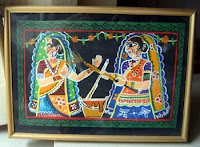A rare Indian art from a Village in Bihar, North India, Madhubani - complete with its small clay and straw huts and narrow lanes.
This small village is the heartland of the internationally acclaimed school of folk art painting called 'Madhubani' or 'Mithila' painting. The origin of Madhubani Paintings is traced back to epic periods with the tradition of painting walls for the purpose of domestic beautification and ceremonial rituals. Natural and mythological figures, added with Hindu deities, besides regional flora and fauna, are painted on houses and village walls to mark the seasonal festivals of the year and for special events of the life cycle, especially the rite of marriage.
The other symbols include the moon, a source of heavenly nectar, the sun to fertilize and impregnate turtles to bring beneficent powers to the matrimonial alliance, parrots to symbolize the couple and fishes for fertility. The human figures are mostly abstract and linear in form; the animals more naturalistic. Colors applied have no shading. Normally a double line is drawn for the outlines, with the gap between the lines filled by cross or tiny straight lines.
In the linear painting, no colors are applied. Only the outlines are drawn. Often, a coat of whitewash is also applied before actually starting the painting. Traditionally, natural colors obtained from plant extracts are used.




